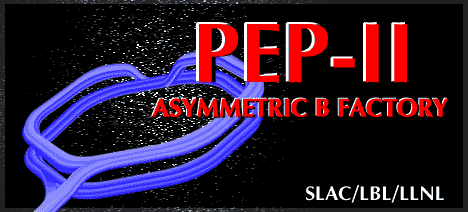 03/01/99 Update
03/01/99 Update
 03/01/99 Update
03/01/99 Update
LER : The LER current was raised to 1171 mA on February 22. We believe this is a world's record stored current for a positron beam. During the run the LER accumulated an additional 133 ampere-hours for a total for 153. The interaction region beta functions were adjusted to be near the design values and the chromaticities were adjusted to be linear and positive. The current is limited by concerns of (1) six adjacent bellows in one arc which show an unusual increase in temperature with beam current of about 40 degrees F on the hottest one and (2) a nonlinear rise in vacuum pressure in the straight sections due most likely to multipactoring electrons. Both of these effects depend on the number of bunches in the ring. The LER arc vacuum pressure is scrubbing at a steady rate but is slowed by several leaks. The transverse, longitudinal, RF low level, and the "woofer" link feedbacks were made fully operational.
HER: The HER integrated current is now near 115 ampere-hours. The transverse, longitudinal, RF low level, and the "woofer" link feedbacks were made fully operational.
Collisions: During this winter run we collided beams for a total of eight days. Various bunch trains were collided including 1, 291, 522, 786, 1048 and 1571 bunches in each beam. The 1571 bunch pattern has the design bunch spacing of every other RF bucket. All of the bunch trains had "ion" gaps of about 10% of the ring. A 1048 bunch train with a 40% gap was not stable for single beam effects in LER. The bunch injection controller was successful tested. This controller selectively picks which bunches are to be filled so that the single bunch currents around the ring are all the same within a few percent. A level filling pattern will help stabilize beam-beam effects over a bunch train.
Many beam-beam scans were done with the aim of reducing the interaction point beam sizes. A vertical "cap-sigma y" of 8.6 microns was achieved, with the design value of 6.8 microns. The measured horizontal sizes were very near the design value of 157 microns. The peak luminosity obtained was 5.2 x 10**32/cm**2/sec with 786 bunches with 354 mA in the HER and 681 mA in the LER. The largest currents collided were 1007 mA in the LER and 251 mA in the HER in 1048 bunches.
Backgrounds: The background detectors located around the interaction region were used over the past year to study the backgrounds from both beams and to predict the radiation levels expected when BaBar is in place. Various background reduction techniques were tried including trajectory steering in the interaction region, energy and betatron collimators, and vacuum pressure changes in the interaction region and the ring arcs. In general the backgrounds are higher than expected but low enough so that BaBar can start data taking after an initial beam scrubbing period.
Schedule: The winter run ended February 22 when the installation of BaBar started. We expect to start PEP-II running again with BaBar on May 7.
Thanks again to all for a most exciting and productive run. I would especially like to thank our visitors for their very active participation: Albert Hofmann, Witold Kozanecki, Alex Lumpkin, Massimo Placidi, and Bruno Zotter.
John Seeman March 1, 1999
Suggestions to: John Seeman
[PEP-II Commissioning Updates] [PEP-II Home Page] [BABAR Detector Home Page] [SLAC Home Page]
Page owner: achan